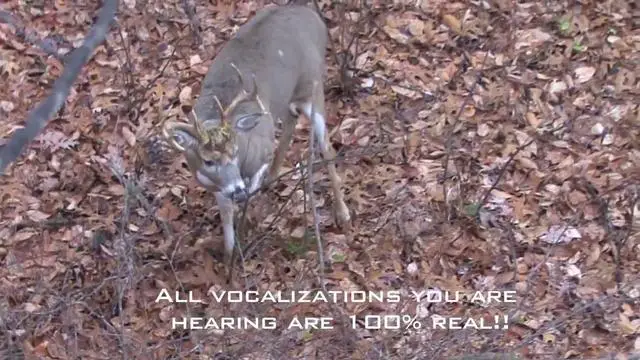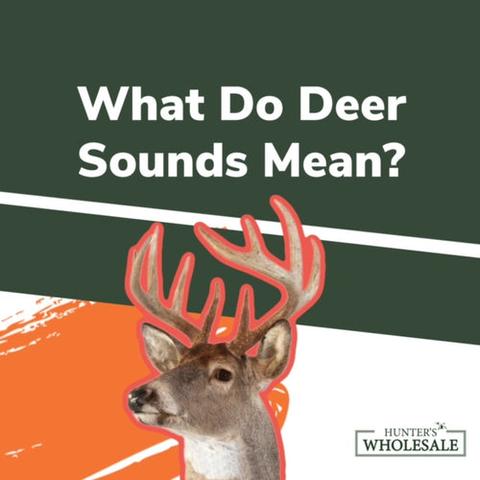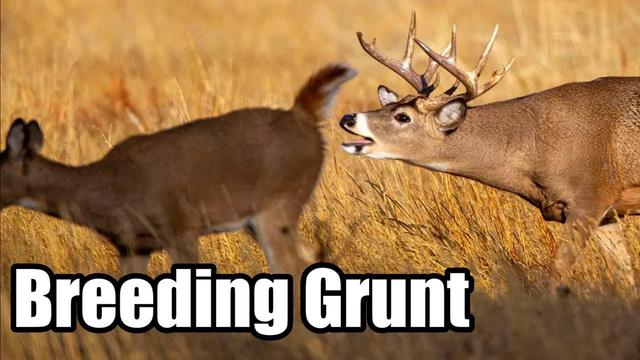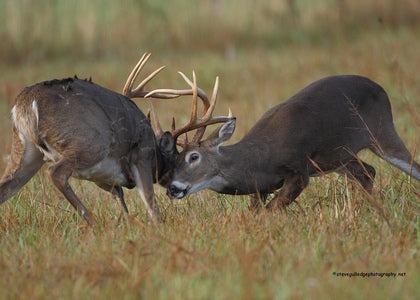Discover the Mystery: Unveiling the Enigmatic Grunt of a Buck Deer
Understanding the Vocalizations of a Buck Deer: What Does a Grunt Sound Like?

Variations in Buck Deer Grunts
The grunt of a buck deer can vary in sound and intensity depending on the situation. It is a low, guttural noise that is commonly associated with communication during the rutting season or mating season. Bucks may produce different variations of grunts to convey various emotions or intentions, such as attracting mates or asserting dominance.
Description of a Buck Deer Grunt
Describing sounds with words has limitations, but the grunt of a buck deer is generally characterized as deep, nasal, and guttural. It may resemble a series of short, rhythmic grunts. However, it’s important to note that specific characteristics of deer vocalizations can vary among individuals and can be influenced by factors such as age, size, and health.
Recordings and Resources
If you are interested in hearing the actual sound of a buck deer grunt, there are online resources available, including wildlife websites and YouTube, where you may find recordings. Listening to recordings can provide a more accurate sense of the sound than a textual description.
Overall, understanding the vocalizations of buck deer can enhance your knowledge about their behavior and communication patterns during specific seasons or situations.
Exploring the Different Sounds of a Buck Deer: The Grunt Vocalization

Deer grunts can vary in sound and intensity, and they are typically used by deer for communication, especially during the mating season. The vocalizations of deer, including grunts, can convey different messages such as asserting dominance, expressing interest in mating, or signaling distress.
Female Deer Grunts
Female deer, or does, often emit a soft, low-pitched grunt. This sound is usually a contact call between does or between a doe and her fawns. It can be a subtle, nasal “ehh” or “urp” sound.
Male Deer Grunts
Male deer, or bucks, produce grunts that can vary in tone and intensity. Bucks may emit short, low grunts during the rut (mating season) to communicate with does or challenge other bucks. These grunts can be deeper and more forceful than doe grunts.
Tending Grunts
A tending grunt is a vocalization made by a buck when he is courting a doe during the mating season. It is a softer, rhythmic sound that may accompany other behaviors such as lip curling (flehmen response) or following closely behind a receptive doe.
Distress Grunts
When a deer is in distress or feels threatened, it may emit a series of sharp, repeated grunts. These distress grunts can serve as an alert to other deer in the area, signaling potential danger.
It’s important to note that the actual sounds can vary among individual deer, and factors such as age, sex, and the specific context of the communication play a role in the nuances of deer vocalizations. Additionally, advancements in technology have allowed researchers and wildlife enthusiasts to record and analyze deer vocalizations more precisely, contributing to a better understanding of their communication.
If you’re interested in hearing deer grunts, you can find recordings online or use electronic deer calls designed to mimic these sounds for hunting or observation purposes.
Decoding Deer Communication: What to Expect from a Buck Deer’s Grunt

Variations in Buck Deer Grunts
A buck deer’s vocalizations, including grunting, can vary depending on the situation. The grunt of a buck deer is often a low, guttural sound that can have different variations. These variations may convey different emotions or intentions, such as attracting mates or asserting dominance. While describing sounds with words has limitations, the grunt of a buck deer is generally described as deep, nasal, and guttural. It may resemble a series of short, rhythmic grunts.
Communication During the Rutting Season
The grunt of a buck deer is commonly associated with communication during the rutting season or mating season. During this time, bucks are actively seeking does for mating. The grunt can serve as a way for bucks to attract mates or establish dominance among other males.
Factors Influencing Deer Vocalizations
Deer vocalizations can vary among individuals and can be influenced by factors such as age, size, and health. Each deer may have its own unique vocalization patterns and nuances when it comes to grunting.
Hearing Buck Deer Grunts
If you are interested in hearing the actual sound of buck deer grunts, there are online resources available such as wildlife websites and YouTube where you may find recordings of these vocalizations. Listening to recordings can provide a more accurate sense of the sound than a textual description.
Overall, understanding the various vocalizations of buck deer, including grunting, can help in decoding their communication signals during different situations and seasons.
Unveiling the Mysteries of Buck Deer Grunts: A Sound Guide
Understanding Buck Deer Grunts
Buck deer vocalizations can vary, and one of the sounds they may produce is a grunt. The grunt of a buck deer is often a low, guttural sound that can have different variations depending on the situation. It is commonly associated with communication during the rutting season or mating season when bucks are actively seeking does for mating. The grunt can convey different emotions or intentions, such as attracting mates or asserting dominance. While describing sounds with words has limitations, the grunt of a buck deer is generally a deep, nasal, and guttural noise. It may resemble a series of short, rhythmic grunts.
Variations in Buck Deer Grunts
The specific characteristics of deer vocalizations can vary among individuals and can be influenced by factors such as age, size, and health. Each buck may have its own unique variation of grunting sound. Additionally, the context in which the grunt is produced can also affect its characteristics. Bucks may emit short, low grunts during the rut to communicate with does or challenge other bucks. These grunts can be deeper and more forceful than doe grunts. A tending grunt is a softer, rhythmic sound made by a buck when courting a doe during the mating season.
Listening to Buck Deer Grunts
If you are interested in hearing the actual sound of buck deer grunts, there are online resources available including wildlife websites and YouTube where you may find recordings of these vocalizations. Listening to recordings can provide a more accurate sense of the sound than a textual description.
In conclusion, buck deer grunts are an important form of communication during the mating season. They can vary in sound and intensity depending on various factors such as the individual deer and the specific context of the communication. Listening to recordings can help you better understand and recognize these vocalizations in the wild.
The Language of Bucks: How to Recognize and Interpret their Grunts

When it comes to communicating, bucks have their own unique language that can be understood by those who know what to listen for. One of the most common vocalizations made by bucks is a grunt. Grunting is often associated with the rutting season or mating season when bucks are actively seeking does for mating.
Types of Grunts
Bucks can produce different variations of grunts depending on the situation and their intentions. Here are some types of grunts you may encounter:
1. Dominance Grunts: These grunts are deep, guttural sounds that bucks use to assert their dominance over other males. It’s a way for them to establish their territory and attract mates.
2. Mating Grunts: Bucks emit grunts during the mating season to communicate with does and express their interest in mating. These grunts can vary in tone and intensity, but they are generally deeper and more forceful than doe grunts.
3. Tending Grunts: When a buck is courting a doe, it may produce softer, rhythmic tending grunts. This vocalization accompanies behaviors such as lip curling or closely following a receptive doe.
4. Distress Grunts: In situations where a deer feels threatened or in distress, it may emit sharp, repeated grunting sounds. These distress grunts serve as an alert to other deer in the area, warning them of potential danger.
Interpreting Buck Grunts
Understanding the meaning behind buck grunts can provide valuable insights into their behavior and intentions. Here are some interpretations:
– Dominance: Deep, forceful grunts usually indicate a buck asserting its dominance over other males in the area.
– Mating Interest: Bucks use grunting as a way to express their interest in mating with does. These grunts may become more frequent and intense as the rutting season progresses.
– Courtship: Tending grunts, accompanied by other courtship behaviors, indicate that a buck is actively pursuing a receptive doe for mating.
– Distress or Danger: Sharp, repeated grunts can signal that a deer feels threatened or in distress. This serves as a warning to other deer nearby.
It’s important to remember that the specific characteristics of buck grunts can vary among individuals and may be influenced by factors such as age, size, and health. Additionally, advancements in technology have allowed for more precise recording and analysis of deer vocalizations, contributing to a better understanding of their communication.
If you’re interested in hearing the actual sounds of buck grunts, there are online resources such as wildlife websites and YouTube where you can find recordings. Listening to these recordings can provide a more accurate sense of the sound than a textual description alone.
A Closer Look at Buck Deer Vocalizations: The Distinctive Grunt Sound

Buck deer vocalizations, specifically their grunts, play an important role in communication during the rutting season or mating season. These grunts can vary in sound and intensity depending on the situation.
1. Variation in Buck Deer Grunts
The grunt of a buck deer is often a low, guttural sound that can have different variations. It can convey different emotions or intentions, such as attracting mates or asserting dominance. While describing sounds with words has limitations, the grunt of a buck deer is generally described as deep, nasal, and guttural. It may resemble a series of short, rhythmic grunts.
2. Context and Factors Influencing Deer Vocalizations
Deer vocalizations can vary among individuals and are influenced by factors such as age, size, and health. For example, bucks may emit short, low grunts during the rut to communicate with does or challenge other bucks. Female deer, or does, often emit soft contact calls between each other or with their fawns.
3. Importance of Recording and Analysis
Advancements in technology have allowed researchers and wildlife enthusiasts to record and analyze deer vocalizations more precisely. This has contributed to a better understanding of their communication patterns and behaviors.
4. Online Resources for Hearing Buck Deer Grunts
If you’re interested in hearing the actual sound of buck deer grunts, there are online resources available including wildlife websites and YouTube where you may find recordings of these vocalizations. Listening to recordings can provide a more accurate sense of the sound than a textual description.
In conclusion, buck deer vocalizations play a significant role in communication during the mating season. The distinctive grunt sound is associated with various emotions and intentions, and the specific characteristics of these vocalizations can vary among individuals. Advancements in technology have allowed for better recording and analysis of deer vocalizations, contributing to a deeper understanding of their communication patterns.
In conclusion, the sound of a buck deer grunt can vary but is generally characterized as a deep, guttural noise. It serves as a vocalization to communicate with other deer and may indicate aggression, dominance, or mating behavior. Understanding and recognizing this distinct sound can be valuable for hunters and wildlife enthusiasts alike in their interactions with these majestic animals.











































